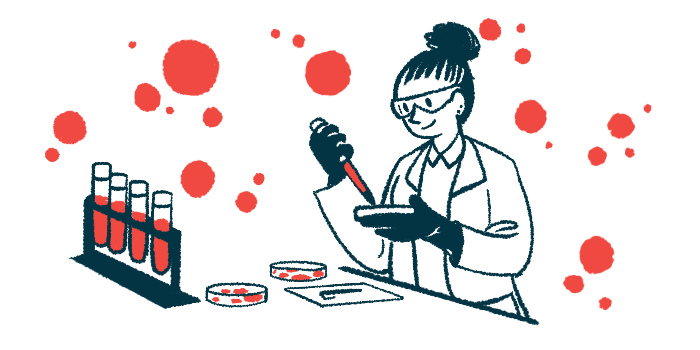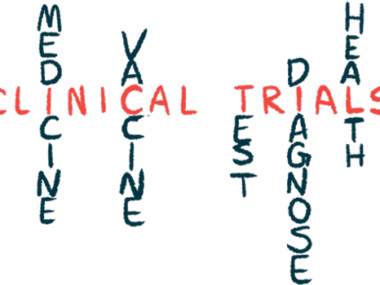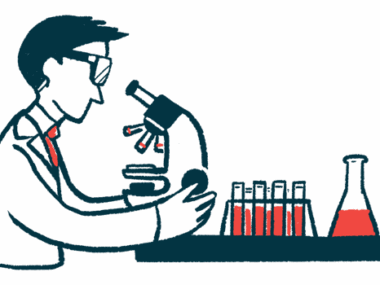4 blood markers may predict outcomes in pulmonary sarcoidosis
Combined, metabolites nearly perfectly ID'd patients with disease progression
Written by |

Four blood metabolites, or intermediate or end products of the body’s metabolism, could serve as noninvasive biomarkers to monitor or predict disease outcomes in people with pulmonary sarcoidosis — in which the lungs are primarily affected by this rare inflammatory disease — according to the results of a new study from researchers in China.
These molecules, namely, uric acid, testosterone sulfate, allopregnanolone sulfate, and 24,25-dihydroxyvitamin D3 (24R,25(OH)2D3), were significantly lower in the blood of patients whose disease worsened compared with those who recovered, the data showed.
Moreover, the researchers noted, when combined, the four metabolites could nearly perfectly discriminate between patients whose disease progressed and those whose did not.
“Beyond aiding in diagnosis, these metabolic markers may serve as indicators for monitoring disease progression and evaluating treatment response,” the team wrote.
The study, “Serum metabolomics in pulmonary sarcoidosis: metabolic signatures across prognoses,” was published in the journal BMC Pulmonary Medicine.
In sarcoidosis, an overly reactive immune system forms granulomas, or clusters of inflammatory immune cells, within various organs, causing symptoms. When the disease mainly affects the lungs, it is called pulmonary sarcoidosis, and is marked by persistent cough, chest pain, and shortness of breath.
“While some patients experience spontaneous resolution or respond well to treatment, others progress to chronic or [scarring] stages despite receiving [bodywide] corticosteroid therapy,” the researchers wrote, noting that progression “often [results] in irreversible lung damage and significantly reduced quality of life.”
A major gap in sarcoidosis care is the absence of simple, noninvasive biomarkers to predict disease progression, according to the team. Without these tools, treatment choices often depend on clinician experience instead of solid evidence, which can result in unnecessary treatments or missed opportunities for early intervention.
Seeking new biomarkers to aid diagnosis, guide treatment
Metabolomics, the study of all metabolites in an organism, cells, or bodily fluid, provides a way to identify disease-specific changes that could represent new biomarkers. Such biomarkers could then help to improve diagnosis, track progression, and guide treatment in pulmonary sarcoidosis.
Yet, the researchers wrote, “most earlier studies have been limited by narrow metabolite coverage and a lack of in-depth exploration of disease [variability] or prognostic stratification.”
Now, a research team from institutions in Shanghai sought to find biomarkers linked to disease progression in pulmonary sarcoidosis. To that end, the team compared blood metabolomic profiles from 29 patients with those from 10 healthy individuals. All were enrolled at Shanghai Pulmonary Hospital between September 2021 and November 2024.
The patients had been followed for a mean of 18.45 months, or about 1.5 years. Those on corticosteroids, standard anti-inflammatory medications, in the six months prior to the study were excluded.
The patient group was mostly comprised of women (75.9%) and had a mean age of 50.41. It was then divided by outcome into a self-healing group (11 patients) and a progressive group (18 patients). The self-healing group saw their disease significantly eased or completely resolved without corticosteroid treatment over follow-up. The progressive group comprised those whose disease required corticosteroids or worsened with or without corticosteroids.
The two groups had similar levels of several blood markers commonly used to monitor disease activity, such as immune T-cells, immune signal molecules, and antibodies. In contrast, blood levels of KL-6, a protein released by damaged lung cells, were significantly higher in the progressive group.
More than 200 metabolites altered in pulmonary sarcoidosis patients
Blood metabolomic profiling showed that levels of 209 metabolites were altered in people with pulmonary sarcoidosis relative to healthy volunteers. Altogether, 10 were found at higher levels and 199 at lower levels.
Most of these metabolites were related to how the body processes amino acids, which are proteins’ building blocks. Some were involved in the metabolism of fatty molecules (lipids) and in immune response pathways.
When patients were grouped by outcome, 25 metabolites, most of which were lipids, clearly differentiated self-healing cases from progressive cases. Eight were found at higher levels, and 17 were found at lower levels, in those with progressive disease.
Drawing from differences observed both between patients and healthy individuals, as well as between patients with self-healing and progressive disease, the researchers identified four key metabolites: uric acid, testosterone sulfate, allopregnanolone sulfate, and 24R,25(OH)2D3.
Uric acid is a normal waste product that results from the breakdown of DNA and RNA building blocks, and 24R,25(OH)2D3 is a vitamin D metabolite. Testosterone sulfate is the metabolite of testosterone, the main male sex hormone, while allopregnanolone sulfate is a metabolite of progesterone, a female sex hormone.
These metabolites were reduced in patients relative to healthy people, and in patients who progressed compared with those who healed without corticosteroids.
The team then assessed their potential to distinguish patients who progressed from those who did not.
The identified metabolic signatures closely reflect the prognostic differences between progressive and self-healing cases.
Tested individually, each of the four metabolites showed good discriminative ability, with an accuracy ranging between 81.8% and 89.9%. When combined, the discriminative potential increased to 97.5%.
“The identified metabolic signatures closely reflect the prognostic differences between progressive and self-healing cases,” the team wrote.
Each metabolite also linked to disease activity measures
Each of these four metabolites also showed clear links to blood biomarkers of disease activity. Lower uric acid was associated with more lung injury and active inflammation, reflected by higher KL-6 and CD8 T-cells, a T-cell subtype linked to tissue damage.
Higher levels of testosterone sulfate and allopregnanolone sulfate were linked to increased IL-2, the immune signal that activates T-cells, and an antibody pattern indicating longer-lasting immune responses. Similarly, rising levels of 24R,25(OH)2D3 were associated with a prolonged antibody-based immune response.
These findings emphasize “the potential of [blood] metabolomics as a valuable tool in the clinical management of sarcoidosis,” and “offer a foundation for future research into personalized treatment and management strategies,” the researchers wrote.







